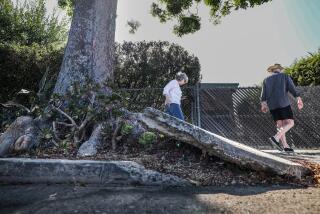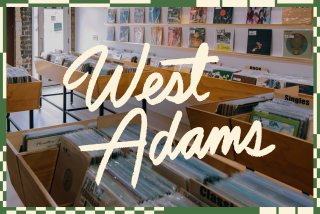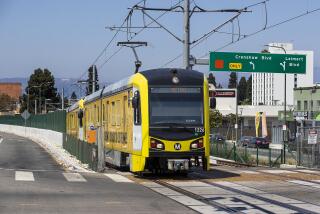La Jolla May Put New Twist on ‘Dip’
- Share via
For more than three generations, it has been a carnival-like confluence of pedestrian and automobile traffic--a La Jolla intersection that seems to have been designed by Disney.
For local motorists, the intersection of Girard Avenue and Prospect Street has been nicknamed “The Dip” for the way Prospect takes a roller-coaster dive south toward the sea just before it meets with Girard.
Pedestrians trying to cross the intersection have a more imposing name for the concrete divider that separates opposing lanes of Prospect: They call it “the Berlin Wall.”
The Depression-era street project scales a steep hill that sweeps down to the Pacific Ocean past La Jolla Cove and the lawns of Ellen Browning Scripps Park.
The intersection affords one of the most breathtaking views of the sea of any public street in downtown La Jolla. But for locals to see it, and for tourists to snap a picture of it, pedestrians must often stand in the street, dodging traffic that comes at them from every direction.
On Thursday, the La Jolla Town Council unveiled plans to create a landscaped pedestrian mall as well as simplify the intersection.
“This project is the product of a design (conference) the Town Council sponsored two years ago, inviting a national group of designers to see what La Jolla could do to reinvest in itself,” architect Martin Pourier said.
In a meeting at the La Jolla public library on Draper Street, architects and Town Council officials met to answer questions from residents and local business concerns, many of whom wondered how the project would be financed and whether the realignment would rob the downtown of some of its precious few parking spaces.
The proposed $3-million project is part of the La Jolla Town Council’s plan to highlight the coastal community’s scenic strengths while ridding it of some of its eyesores.
The project would do away with the concrete retaining wall and its bright turquoise railing as well as the one-way strip of Prospect Street heading south, replacing them with a pedestrian mall that includes an ocean overlook area.
The sidewalks along Prospect Street would be widened in some areas from 15 to 30 feet to make way for tables and sidewalk cafes, Pourier said. Meanwhile, Prospect Street would run into “The Dip” and back up the other side to Herschal Avenue, with parking on at least one side of the street.
Aesthetic changes along Girard and Silverado avenues are also included--suggestions that include uniform lampposts, more trees and street corner trellises.
“It’s an elegant idea, but people get real tight when it comes to their pocketbooks,” said La Jolla resident Althea Brimm. “I’ve lived here for 28 years, and they come up with an idea like this every three or four years.
“It’s great, but if they’re relying on property owners around here to pay for it, it’ll never pass. We’ll never see it.”
Isabell Baresch, the 89-year-old manager of the La Jolla historical society, is also skeptical of the project, but for a different reason. Baresch, who moved to La Jolla in 1910, recalls walking down “The Dip” to the beach in 1912, when the whole area wasn’t a chic commercial district but a dirt slope that supported only chaparral.
“I know it’s a beautiful view,” she said of the intersection. “And I’d like to leave it just the way it is. But they won’t.
“I mean, look around at the way they’ve changed La Jolla. Too many people, too many cars. They don’t know enough to leave a good thing alone.”
Planners say the intersection redesign would be paid for by assessing property owners near the project in the commercial district.
Rudy Gonzales, a member of San Diego’s economic development staff, told about 50 local people who attended the meeting that the city can offer little help in the way of bonds to pay for the measure.
“Funding is available,” he said. “But it’s going to have to come from your own community. Don’t let that stop you from trying.”
The town council is merely an advisory body and, even after Thursday’s public forum, the project still must pass through the normal planning avenues before development begins.
James Alcorn, an architect and member of the VISTA committee, a town council subcommittee assigned to examine La Jolla’s streets and coastline, said “The Dip’ is mentioned in most conversations about how downtown La Jolla can be improved.
“It offers one of the best views of the sea in La Jolla,” he said. “Unfortunately, nobody can use it without wading out into the traffic.”
Pourier, a partner of the Spurlock Office, a local landscape architectural firm contracted by the town council to research the project, described people’s problems with the intersection in even more vivid terms.
“It’s a mess,” he said. “The most typical thing I see are tourists who get trapped in the intersection between Girard Avenue and Prospect Street, people stuck in a no-man’s-land with traffic coming every which way.
“Cars who come up to the intersection heading south often don’t know which way to go, down the hill or continue along a one-way strip of Prospect. And, while they decide, people get caught up in the whirlpool of cars.”
“The Dip was a key area to be looked at with its confusing two-way and one-way traffic,” Pourier said. “With the redesign, all the traffic would move in a continuous two-way pattern down one side of the dip and up the other.”
Pourier said the project would become the “front porch for the village.”
“They tore down the Berlin Wall in Germany not long ago. So we figured it was a good time to take a look at this one.”
More to Read
Sign up for Essential California
The most important California stories and recommendations in your inbox every morning.
You may occasionally receive promotional content from the Los Angeles Times.














